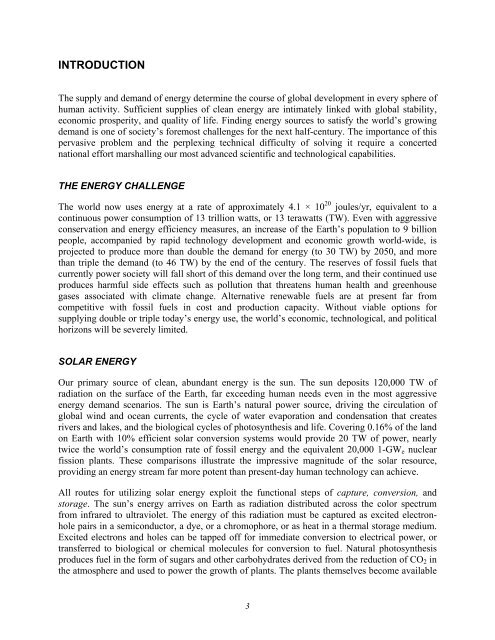Basic Research Needs for Solar Energy Utilization - Office of ...
Basic Research Needs for Solar Energy Utilization - Office of ...
Basic Research Needs for Solar Energy Utilization - Office of ...
Create successful ePaper yourself
Turn your PDF publications into a flip-book with our unique Google optimized e-Paper software.
INTRODUCTION<br />
The supply and demand <strong>of</strong> energy determine the course <strong>of</strong> global development in every sphere <strong>of</strong><br />
human activity. Sufficient supplies <strong>of</strong> clean energy are intimately linked with global stability,<br />
economic prosperity, and quality <strong>of</strong> life. Finding energy sources to satisfy the world’s growing<br />
demand is one <strong>of</strong> society’s <strong>for</strong>emost challenges <strong>for</strong> the next half-century. The importance <strong>of</strong> this<br />
pervasive problem and the perplexing technical difficulty <strong>of</strong> solving it require a concerted<br />
national ef<strong>for</strong>t marshalling our most advanced scientific and technological capabilities.<br />
THE ENERGY CHALLENGE<br />
The world now uses energy at a rate <strong>of</strong> approximately 4.1 × 10 20 joules/yr, equivalent to a<br />
continuous power consumption <strong>of</strong> 13 trillion watts, or 13 terawatts (TW). Even with aggressive<br />
conservation and energy efficiency measures, an increase <strong>of</strong> the Earth’s population to 9 billion<br />
people, accompanied by rapid technology development and economic growth world-wide, is<br />
projected to produce more than double the demand <strong>for</strong> energy (to 30 TW) by 2050, and more<br />
than triple the demand (to 46 TW) by the end <strong>of</strong> the century. The reserves <strong>of</strong> fossil fuels that<br />
currently power society will fall short <strong>of</strong> this demand over the long term, and their continued use<br />
produces harmful side effects such as pollution that threatens human health and greenhouse<br />
gases associated with climate change. Alternative renewable fuels are at present far from<br />
competitive with fossil fuels in cost and production capacity. Without viable options <strong>for</strong><br />
supplying double or triple today’s energy use, the world’s economic, technological, and political<br />
horizons will be severely limited.<br />
SOLAR ENERGY<br />
Our primary source <strong>of</strong> clean, abundant energy is the sun. The sun deposits 120,000 TW <strong>of</strong><br />
radiation on the surface <strong>of</strong> the Earth, far exceeding human needs even in the most aggressive<br />
energy demand scenarios. The sun is Earth’s natural power source, driving the circulation <strong>of</strong><br />
global wind and ocean currents, the cycle <strong>of</strong> water evaporation and condensation that creates<br />
rivers and lakes, and the biological cycles <strong>of</strong> photosynthesis and life. Covering 0.16% <strong>of</strong> the land<br />
on Earth with 10% efficient solar conversion systems would provide 20 TW <strong>of</strong> power, nearly<br />
twice the world’s consumption rate <strong>of</strong> fossil energy and the equivalent 20,000 1-GWe nuclear<br />
fission plants. These comparisons illustrate the impressive magnitude <strong>of</strong> the solar resource,<br />
providing an energy stream far more potent than present-day human technology can achieve.<br />
All routes <strong>for</strong> utilizing solar energy exploit the functional steps <strong>of</strong> capture, conversion, and<br />
storage. The sun’s energy arrives on Earth as radiation distributed across the color spectrum<br />
from infrared to ultraviolet. The energy <strong>of</strong> this radiation must be captured as excited electronhole<br />
pairs in a semiconductor, a dye, or a chromophore, or as heat in a thermal storage medium.<br />
Excited electrons and holes can be tapped <strong>of</strong>f <strong>for</strong> immediate conversion to electrical power, or<br />
transferred to biological or chemical molecules <strong>for</strong> conversion to fuel. Natural photosynthesis<br />
produces fuel in the <strong>for</strong>m <strong>of</strong> sugars and other carbohydrates derived from the reduction <strong>of</strong> CO2 in<br />
the atmosphere and used to power the growth <strong>of</strong> plants. The plants themselves become available<br />
3
















